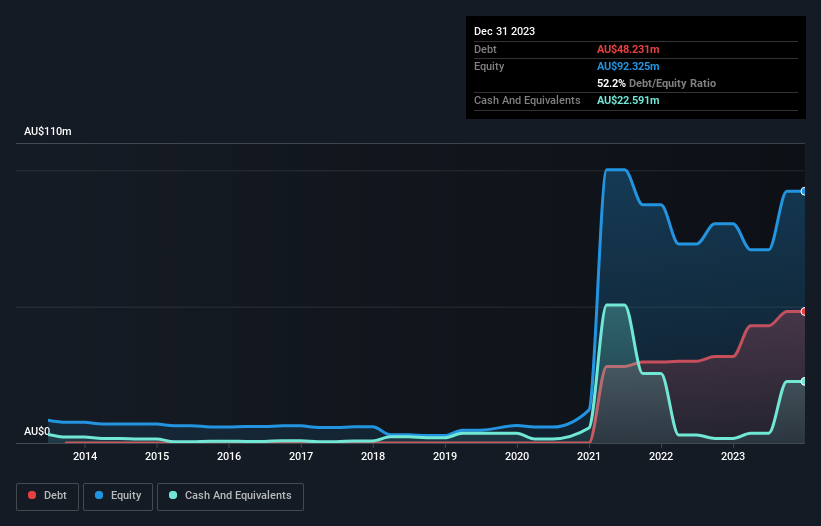Stock Analysis
- Australia
- /
- Metals and Mining
- /
- ASX:CYM
Is Cyprium Metals (ASX:CYM) Weighed On By Its Debt Load?

Some say volatility, rather than debt, is the best way to think about risk as an investor, but Warren Buffett famously said that 'Volatility is far from synonymous with risk.' When we think about how risky a company is, we always like to look at its use of debt, since debt overload can lead to ruin. We can see that Cyprium Metals Limited (ASX:CYM) does use debt in its business. But should shareholders be worried about its use of debt?
When Is Debt A Problem?
Generally speaking, debt only becomes a real problem when a company can't easily pay it off, either by raising capital or with its own cash flow. If things get really bad, the lenders can take control of the business. However, a more common (but still painful) scenario is that it has to raise new equity capital at a low price, thus permanently diluting shareholders. Having said that, the most common situation is where a company manages its debt reasonably well - and to its own advantage. When we think about a company's use of debt, we first look at cash and debt together.
See our latest analysis for Cyprium Metals
How Much Debt Does Cyprium Metals Carry?
The image below, which you can click on for greater detail, shows that at December 2023 Cyprium Metals had debt of AU$48.2m, up from AU$31.7m in one year. However, it does have AU$22.6m in cash offsetting this, leading to net debt of about AU$25.6m.

How Strong Is Cyprium Metals' Balance Sheet?
According to the last reported balance sheet, Cyprium Metals had liabilities of AU$19.1m due within 12 months, and liabilities of AU$71.5m due beyond 12 months. On the other hand, it had cash of AU$22.6m and AU$100.0k worth of receivables due within a year. So it has liabilities totalling AU$67.9m more than its cash and near-term receivables, combined.
This deficit casts a shadow over the AU$44.2m company, like a colossus towering over mere mortals. So we definitely think shareholders need to watch this one closely. At the end of the day, Cyprium Metals would probably need a major re-capitalization if its creditors were to demand repayment. The balance sheet is clearly the area to focus on when you are analysing debt. But you can't view debt in total isolation; since Cyprium Metals will need earnings to service that debt. So when considering debt, it's definitely worth looking at the earnings trend. Click here for an interactive snapshot.
Given its lack of meaningful operating revenue, investors are probably hoping that Cyprium Metals finds some valuable resources, before it runs out of money.
Caveat Emptor
Importantly, Cyprium Metals had an earnings before interest and tax (EBIT) loss over the last year. Its EBIT loss was a whopping AU$20m. Considering that alongside the liabilities mentioned above make us nervous about the company. We'd want to see some strong near-term improvements before getting too interested in the stock. Not least because it burned through AU$19m in negative free cash flow over the last year. That means it's on the risky side of things. When analysing debt levels, the balance sheet is the obvious place to start. However, not all investment risk resides within the balance sheet - far from it. For instance, we've identified 6 warning signs for Cyprium Metals (4 are a bit unpleasant) you should be aware of.
If, after all that, you're more interested in a fast growing company with a rock-solid balance sheet, then check out our list of net cash growth stocks without delay.
Valuation is complex, but we're helping make it simple.
Find out whether Cyprium Metals is potentially over or undervalued by checking out our comprehensive analysis, which includes fair value estimates, risks and warnings, dividends, insider transactions and financial health.
View the Free AnalysisHave feedback on this article? Concerned about the content? Get in touch with us directly. Alternatively, email editorial-team (at) simplywallst.com.
This article by Simply Wall St is general in nature. We provide commentary based on historical data and analyst forecasts only using an unbiased methodology and our articles are not intended to be financial advice. It does not constitute a recommendation to buy or sell any stock, and does not take account of your objectives, or your financial situation. We aim to bring you long-term focused analysis driven by fundamental data. Note that our analysis may not factor in the latest price-sensitive company announcements or qualitative material. Simply Wall St has no position in any stocks mentioned.

Simply Wall St
About ASX:CYM
Cyprium Metals
Cyprium Metals Limited engages in the identifying, exploration, evaluation, and development of mineral properties in Australia.
Mediocre balance sheet and slightly overvalued.
